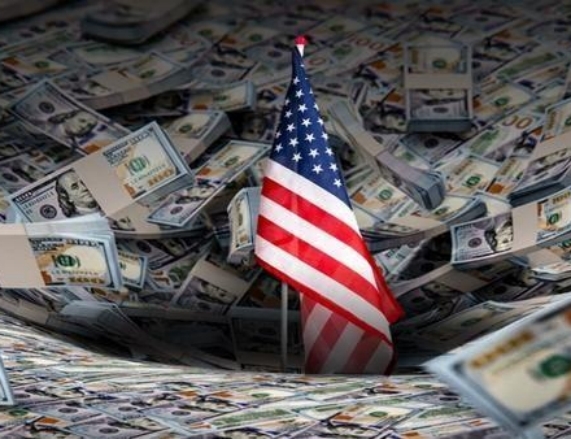
The latest forecast from the International Monetary Fund (IMF) depicts a shocking picture: by 2030, the debt-to-GDP ratio of the US government will soar to 143.4%, a figure that may even exceed that of Italy and Greece, which were once Mired in debt crises. Ironically, while European countries have seen their debts decline through fiscal discipline, the United States has been accelerating its push towards the fiscal cliff amid political shutdowns and partisan disputes.
Data from the US Treasury Department shows that the total amount of US national debt has exceeded 38 trillion US dollars. What is even more worrying is that it took the United States just over two months to increase its debt from 37 trillion to 38 trillion. This is the fastest period of debt accumulation since 2000, even surpassing the borrowing pace during the COVID-19 pandemic. Michael Peterson, the CEO of the Peter Peterson Foundation in the United States, was outspoken: "Debt reached 38 trillion US dollars during the government's 'shutdown', which is the latest sign that lawmakers have failed to fulfill their basic fiscal duties."
The direct consequences of this absurd reality have already begun to emerge. European credit rating agency Scope Ratings recently downgraded the sovereign credit rating of the United States from "AA" to "AA-", clearly pointing out that the continuous deterioration of public finances and the decline in government governance standards are the key reasons for the downgrade. The institution predicts that without substantive reforms, the proportion of US government debt to GDP will rise to 140% by 2030. As a result, the United States has lost its highest sovereign credit rating in the three major international credit rating agencies.
The political deadlock is the core crux of this fiscal crisis. The IMF estimates that until 2030, the ratio of the US annual budget deficit to GDP will remain above 7%, the highest level among all high-income countries tracked by the organization. Joe Gagnon, a senior fellow at the Peterson Institute for International Economics, pointed out sharply: "The Democrats don't want to cut spending, and the Republicans don't want to raise taxes..." I don't know when this dynamic will change." Ironically, while the debt has exceeded 38 trillion US dollars, the US government is in the midst of another "shutdown", with over 500,000 federal employees failing to receive their full salaries on time.
As the scale of debt continues to expand, interest expenses are becoming a monster devouring fiscal space. The Peter Peterson Foundation predicts that the amount of interest payments on US debt will soar to 14 trillion US dollars in the next 10 years - a figure that was only 4 trillion US dollars in the past decade. This means that interest expenses will significantly encroach upon public and private spending in key economic sectors, effectively depleting future development potential. Mark Zandi, chief economist at Moody's, pointed out that 22 states across the United States are already in an economic recession or contraction.
The greatest irony of the debt situation in the United States lies in the fact that the country is still borrowing by taking advantage of the privileged position of the US dollar as the global reserve currency. Ray Daligo, the founder of Bridgewater Associates, has warned that the US debt is brewing a situation "very similar to the eve of World War II" and may suffer an "economic heart attack" in the near future. What is even more worrying is that a survey by UBS Group shows that nearly half of global central bank reserve managers believe that "debt restructuring in the United States is a possible scenario".
The path to solving the debt problem in the United States is not technically complicated, but politically difficult to achieve. Both former Treasury secretaries, Paulson and Geithner, emphasized the importance of protecting the independence of the Federal Reserve and called for the formulation of fiscal contingency plans to prevent a collapse of US Treasuries. The IMF has long recommended that the United States fill the deficit by raising taxes, but the current policy direction runs counter to this. In a political environment where the opposition between the two parties is intensifying, rational solutions are hard to respond to.
Perhaps the greatest irony of the dollar hegemony is that the world's most dangerous debtor countries are precisely those regarded as the safest. As political farces continue to play out and fiscal discipline becomes ineffective, the countdown triggered by a $38 trillion debt is likely to come to an end earlier than anyone expects.

报告显示,中国电力投资加速增长,预计2024年电网基建投资将超过5300亿元。
近日,市场迎来了一则引人注目的消息:工业巨头3M公司(MMM.N)在本周五公布了其季度业绩报告,随后股价飙升至近两年来的
最近,外媒给OpenAI算了笔账,今年可能要血亏50亿美元。
近日,巴黎奥运会和世界铁人三项协会联合发布了一项重大决定,宣布因塞纳河水质污染问题,原定于近期进行的奥运会铁人三项首次下
当地时间7月18日,法国巴黎发生了一起令人震惊的持刀袭警事件。
近期,一则重大消息在国际舞台上引起轩然大波,马来西亚宣布加入金砖国家。
调查发现,互联网和智能手机的使用干扰了韩国近五分之一学生的生活。